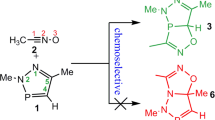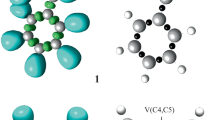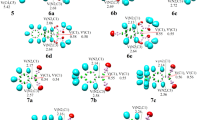Abstract
A molecular electron density theory (MEDT) study is performed for the [3 + 2] cycloaddition (32CA) reactions of benzonitrile oxide (BNO) and diphenyldiazomethane (DPDM) to cyclopentene (CP) and norbornene (NBN) with the objective to analyse the experimentally observed acceleration in NBN reactions relative to the CP ones. The activation enthalpy of the 32CA reaction of NBN with BNO is lowered than that of CP by 2.1–2.9 kcal mol−1 in gas phase, DMSO, acetonitrile and THF, while the corresponding differences are 1.3–1.8 kcal mol−1 with DPDM. The 32CA reactions of DPDM show lower activation parameters compared to that of BNO consistent with the respective pseudo(mono)radical and zwitterionic type characters of DPDM and BNO. The syn diastereofacial approach of NBN is energetically feasible compared to the anti one. The global electron density transfer (GEDT) is identified to anticipate the minimal electron density flux at the TS entity, which is otherwise not accounted by the global electrophilicities of the separated regents. This MEDT study allows comprehending that for these non-polar reactions, the acceleration in NBN cycloadditions compared to the CP ones is due to the relatively lower energy cost demanded for the depopulation and subsequent rupture of C–C double bond of NBN followed by sequential bonding changes along the reaction paths, rather than the “predistorted geometry towards the TSs” as previously proposed in the 32CA reactions of norbornene derivatives.










Similar content being viewed by others
References
Flid VR, Gringolts ML, Shamsiev RS, Finkelshtein ES (2018) Norbornene, norbornadiene and their derivatives: promising semi-products for organic synthesis and production of polymeric materials. Russ Chem Rev 87:1169–1205. https://doi.org/10.1070/RCR4834
Chowdhury S, Tanaka R, Nakayama Y, Shiono T (2020) Synthesis of norbornene/divinylbenzene copolymers catalyzed by anilinonaphthoquinone-ligated nickel complexes and their applications for the synthesis of graft polymers. J Polym Sci 58:1564–1570. https://doi.org/10.1002/pol.20200133
Madl CM, Heilshorn SC (2018) Bioorthogonal strategies for engineering extracellular matrices. Adv Func Mater 28:1706046. https://doi.org/10.1002/adfm.201706046
Zheng M, Zheng L, Zheng P, Li J, Zhang Y (2015) Development of bioorthogonal reactions and their applications in bioconjugation. Molecules 20:3190–3205. https://doi.org/10.3390/molecules20023190
Ivin KJ, Mol JC (1997) Olefin metathesis and metathesis polymerization, 2nd edn. Academic Press, London
Hobbs CE, Lin B, Malinski T (2015) Norbornene derivatives from a metal-free, strain-promoted cycloaddition reaction: new building blocks for ring-opening metathesis polymerization reactions. J Polym Sci Part A Polym Chem 53:2357–2362. https://doi.org/10.1002/pola.27691
Truog VX, Zhou K, Simon GP, Forsythe JS (2015) Nitrile oxide-norbornene cycloaddition as a bioorthogonal crosslinking reaction for the preparation of hydrogels. Marcromol Rapid Commun 36:1729–1734. https://doi.org/10.1002/marc.201500314
Daştan A, Balci M (2005) High temperature bromination. part 18: Bromination of benzonorbornadiene derivatives: polybrominated benzonorbornenes and benzonorbornadienes. Tetrahedron 61:5481–5488. https://doi.org/10.1016/j.tet.2005.03.132
Sauers RR, Sonnet PE (1964) Prins reaction of norbornene. J Org Chem 29:754–755. https://doi.org/10.1021/jo01026a503
Chow YL, Cheng XE (1993) The reaction pattern of norbornene with excited state carbonyl compounds: photochemical preparations of norbornene derivatives. Res Chem Intermed 19:211–234. https://doi.org/10.1163/156856793X00082
Zhang X, Zhang O, Wu Y, Feng C, Xie C, Fan X, Li P (2016) Polyaddition of azide-containing norbornene-based monomer through strain-promoted 1,3-dipolar cycloaddition reaction. Macromol Rapid Commun 37:1311–1317. https://doi.org/10.1002/marc.201600233
Breugst M, Reissig H-U (2020) The Huisgen reaction: milestones of the 1,3-dipolar cycloaddition. Angew Chem Int Ed 59:12293–12307. https://doi.org/10.1002/anie.202003115
Scheiner P, Schomaker JH, Deming S, Libbey WJ, Nowack GP (1965) The addition of aryl azides to norbornene. a kinetic investigation. J Am Chem Soc 87:306–311. https://doi.org/10.1021/ja01080a030
Huisgen R (1963) Kinetics and mechanism of 1,3-dipolar cycloadditions. Angew Chem Int Ed 2:633–645 https://doi.org/10.1002/anie.196306331
Lopez SA, Houk KN (2013) Alkene distortion energies and torsional effects control reactivities, and stereoselectivities of azide cycloadditions to norbornene and substituted norbornenes. J Org Chem 78:1778–1783. https://doi.org/10.1021/jo301267b
Domingo LR, Acharjee N (2020) Unravelling the strain-promoted [3+2] cycloaddition reactions of phenyl azide with cycloalkynes from the molecular electron density theory perspective. New J Chem 44:13633–13643. https://doi.org/10.1039/D0NJ02711A
Domingo LR (2016) Molecular electron density theory: a modern view of reactivity in organic chemistry. Molecules 21:1319. https://doi.org/10.3390/molecules21101319
Ríos-Gutiérrez M, Domingo LR (2019) Unravelling the mysteries of the [3+2] cycloaddition reactions. Eur J Org Chem 2:267–282. https://doi.org/10.1002/ejoc.201800916
Domingo LR, Acharjee N (2020) Molecular Electron Density Theory: A New Theoretical Outlook on Organic Chemistry. In Ul-Haq Z, Wilson AK (ed) Frontiers in Computational Chemistry. Bentham and Science, Singapore 5:174–227 https://doi.org/10.2174/9789811457791120050007
Adjieufack AI, Ndassa IM, Mbadcam JK, Ríos-Gutiérrez M, Domingo LR (2017) Steric interactions controlling the syn stereofacial selectivity in the [3 + 2] cycloaddition reaction between acetonitrile oxide and 7-oxanorborn-5-en-2-ones: a molecular electron density theory study. J Phys Org Chem 30:e3710. https://doi.org/10.1002/poc.3710
Domingo LR, Ríos-Gutiérrez M, Acharjee N (2021) Unveiling the unexpected reactivity of electrophilic diazoalkanes in [3+2] cycloaddition reactions within molecular electron density theory. Chemistry 3:74–93. https://doi.org/10.3390/chemistry3010006
Domingo LR, Ríos-Gutiérrez M, Pérez P (2018) A molecular electron density theory study of the reactivity and selectivities in [3 + 2] cycloaddition reactions of C,N-Dialkyl Nitrones with ethylene derivatives. J Org Chem 83:2182-2197 https://doi.org/10.1021/acs.joc.7b03093
Domingo LR, Acharjee N (2020) Unveiling the high reactivity of strained dibenzocyclooctyne in [3+2] cycloaddition reactions with diazoalkanes through the molecular electron density theory. J Phys Org Chem 33:e4100. https://doi.org/10.1002/poc.4100
Salim HAM, Acharjee N, Domingo LR, Abdallah HH (2021) A molecular electron density theory study for [3+2] cycloaddition reactions of 1-pyrroline-1-oxide with disubstituted acetylenes leading to bicyclic 4-isoxazolines. Int J Quant Chem 121:e26503. https://doi.org/10.1002/qua.26503
Domingo LR, Ríos-Gutiérrez M, Acharjee N (2019) A molecular electron density theory study of the chemoselectivity, regioselectivity, and diastereofacial selectivity in the synthesis of an anticancer spiroisoxazoline derived from α-santonin. Molecules 24:832. https://doi.org/10.3390/molecules24050832
Domingo LR, Acharjee N (2020) A molecular electron density theory study of the Grignard reagent-mediated regioselective direct synthesis of 1,5-disubstituted-1,2,3-triazoles. J Phys Org Chem 33:e4062. https://doi.org/10.1002/poc.4062
Salim HAM, Acharjee N, Abdallah HH (2021) Insights into the mechanism and regioselectivity of the [3 + 2] cycloaddition reactions of cyclic nitrone to nitrile functions with a molecular electron density theory perspective. Theor Chem Acc 140:1. https://doi.org/10.1007/s00214-020-02703-y
Domingo LR, Acharjee N, Salim HAM (2020) Understanding the reactivity of trimethylsilyldiazoalkanes participating in [3+2] cycloaddition reactions towards diethylfumarate with a molecular electron density theory perspective. Organics 1:3–18. https://doi.org/10.3390/org1010002
Becke AD, Edgecombe KE (1990) A simple measure of electron localization in atomic and molecular systems. J Chem Phys 92:5397–5403. https://doi.org/10.1063/1.458517
Silvi B, Savin A (1994) Classification of chemical bonds based on topological analysis of electron localization functions. Nature 371:683–686. https://www.nature.com/articles/371683a0
Geerlings P, De Proft F, Langenaeker W (2003) Conceptual density functional theory. Chem Rev 103:1793–1874. https://doi.org/10.1021/cr990029p
Domingo LR, Ríos-Gutiérrez M, Pérez P (2016) Applications of the conceptual density functional theory indices to organic chemistry reactivity. Molecules 21:748 https://doi.org/10.3390/molecules21060748
Domingo LR, Aurell MJ, Pérez P, Contreras R (2002) Quantitative characterization of the global electrophilicity power of common diene/dienophile pairs in Diels–Alder reactions. Tetrahedron 58:4417-4423. https://doi.org/10.1016/S0040-4020(02)00410-6
Jaramillo P, Domingo LR, Chamorro E, Pérez P (2008) A further exploration of a nucleophilicity index based on the gas-phase ionization potentials. J Mol Struct THEOCHEM 865:68–72. https://doi.org/10.1016/j.theochem.2008.06.022
Fukui K (1970) Formulation of the reaction coordinate. J Phys Chem 74:4161–4163. https://doi.org/10.1021/j100717a029
Thom R (1972) Stabilité Structurelle et Morphogenèse (Interéditions), Paris
Bader RFW (1990) Atoms in molecules: a quantum theory. Clarendon Press, Oxford
Bader RFW, Essén H (1984) The characterization of atomic interactions. J Chem Phys 80:1943–1960. https://doi.org/10.1063/1.446956
Kumar PSV, Raghavendra V, Subramanian V (2016) Bader’s theory of atoms in molecules (AIM) and its applications to chemical bonding. J Chem Sci 128:1527–1536. https://doi.org/10.1007/s12039-016-1172-3
Zhao Y, Truhlar DG (2004) Hybrid meta density functional theory methods for thermochemistry, thermochemical kinetics, and noncovalent interactions: the MPW1B95 and MPWB1K models and comparative assessments for hydrogen bonding and van der waals interactions. J Phys Chem A 108:6908–6918. https://doi.org/10.1021/jp048147q
Hehre WJ, Radom L, Schleyer PVR, Pople J (1986) Ab initio molecular orbital theory. Wiley, New York, USA
Schlegel HB (1982) Optimisation of equilibrium geometries and transition structures. J Comput Chem 3:214–218. https://doi.org/10.1002/jcc.540030212
González C, Schlegel HB (1990) Reaction path following in mass-weighted internal coordinates. J Phys Chem 94:5523–5527. https://doi.org/10.1021/j100377a021
González C, Schlegel HB (1991) Improved algorithms for reaction path following: higher-order implicit algorithms. Chem Phys 95:5853–5860. https://doi.org/10.1063/1.461606
Parr RG, Yang W (1989) Density functional theory of atoms and molecules. Oxford University Press, Oxford
Parr RG, Pearson RG (1983) Absolute hardness: companion parameter to absolute electronegativity. J Am Chem Soc 105:7512–7516. https://doi.org/10.1021/ja00364a005
Domingo LR (2014) A new C–C bond formation model based on the quantum chemical topology of electron density. RSC Adv 4:32415–32428. https://doi.org/10.1039/C4RA04280H
Reed AE, Weinstock RB, Weinhold F (1985) Natural population analysis. J Chem Phys 83:735–746. https://doi.org/10.1063/1.449486
Reed AE, Curtiss LA, Weinhold F (1988) Intermolecular interactions from a natural bond orbital, donor-acceptor viewpoint. Chem Rev 88:899–926. https://doi.org/10.1021/cr00088a005
Jasiński R (2015) A stepwise, zwitterionic mechanism for the 1,3-dipolar cycloaddition between (Z)-C-4-methoxyphenyl-N-phenylnitrone and gem-chloronitroethene catalysed by 1-butyl-3-methylimidazolium ionic liquid cations. Tetrahedron Lett 56:532–535. https://doi.org/10.1016/j.tetlet.2014.12.007
Tomasi J, Persico M (1994) Molecular interactions in solution: an overview of methods based on continuous distributions of the solvent. Chem Rev 94:2027–2094. https://doi.org/10.1021/cr00031a013
Simkin BY, Sheikhet I (1995) Quantum chemical and statistical theory of solutions-a computational approach. Ellis Horwood, London
Cances E, Mennucci B, Tomasi J (1997) A new integral equation formalism for the polarizable continuum model: theoretical background and applications to isotropic and anisotropic dielectrics. J Chem Phys 107:3032–3041. https://doi.org/10.1063/1.474659
Cossi M, Barone V, Cammi R, Tomasi J (1996) Ab initio study of solvated molecules: a new implementation of the polarizable continuum model. Chem Phys Lett 255:327–335. https://doi.org/10.1016/0009-2614(96)00349-1
Barone V, Cossi M, Tomasi J (1998) Geometry optimisation of molecular structures in solution by the polarizable continuum model. J Comput Chem 19:404–417. https://doi.org/10.1002/(SICI)1096-987X(199803)19:4%3c404::AID-JCC3%3e3.0.CO;2-W
Frisch M, Trucks G, Schlegel H, Scuseria G, Robb M, Cheeseman J, Scalmani G, Barone V, Petersson G, Nakatsuji H, Gaussian 16. Revision A (2016), 3.
Lu T, Chen F (2012) Multiwfn: a multifunctional wavefunction analyzer. J Comp Chem 33:580–592. https://doi.org/10.1002/jcc.22885
Pettersen EF, Goddard TD, Huang CC, Couch GS, Greenblatt DM, Meng CC, Ferrin TE (2004) UCSF Chimera–a visualization system for exploratory research and analysis. J Comput Chem 25:1605–1612. https://doi.org/10.1002/jcc.20084
Domingo LR, Chamorro E, Pérez P (2010) Understanding the high reactivity of the azomethine ylides in [3 + 2] cycloaddition reactions. Lett Org Chem 7:432–439. https://doi.org/10.2174/157017810791824900
Ríos-Gutiérrez M, Domingo LR (2019) The carbenoid-type reactivity of simplest nitrile imine from a molecular electron density theory perspective. Tetrahedron 75:1961–1967. https://doi.org/10.1016/j.tet.2019.02.014
Domingo LR, Ríos-Gutiérrez M, Pérez P (2020) A molecular electron density theory study of the participation of tetrazines in aza-Diels–Alder reactions. RSC Adv 10:15394–15405. https://doi.org/10.1039/D0RA01548B
Domingo LR, Arnó M, Andrés J (1999) Influence of reactant polarity on the course of the inverse-electron-demand Diels-Alder reaction. A DFT study of regio-and stereoselectivity, presence of lewis acid catalyst, and inclusion of solvent effects in the reaction between nitroethene and substituted ethenes. J Org Chem 64:5867–5875. https://doi.org/10.1021/jo990331y
Domingo LR, Aurell MJ, Pérez P, Contreras R (2003) Origin of the synchronicity on the transition structures of polar Diels-Alder reactions. Are these reactions [4 + 2] processes? J Org Chem 68:3884–3890. https://doi.org/10.1021/jo020714n
Domingo LR, Sáez JA (2009) Understanding the mechanism of polar Diels-Alder reactions. Org Biomol Chem 7:3576–3583. https://doi.org/10.1039/B909611F
Domingo LR, Ríos-Gutiérrez M, Pérez P (2017) How does the global electron density transfer diminish activation energies in polar cycloaddition reactions? A molecular electron density theory study. Tetrahedron 73:1718–1724. https://doi.org/10.1016/j.tet.2017.02.012
Krokidis X, Noury S, Silvi B (1997) Characterization of elementary chemical processes by catastrophe theory. J Phys Chem A 101:7277–7282. https://doi.org/10.1021/jp9711508
Andrés J, González-Navarrete P, Safont VS, Silvi B (2017) Curly arrows, electron flow, and reaction mechanisms from the perspective of the bonding evolution theory. Phys Chem Chem Phys 19:29031–29046. https://doi.org/10.1039/C7CP06108K
Author information
Authors and Affiliations
Corresponding author
Additional information
Publisher's Note
Springer Nature remains neutral with regard to jurisdictional claims in published maps and institutional affiliations.
Supplementary Information
Below is the link to the electronic supplementary material.
Rights and permissions
About this article
Cite this article
Acharjee, N., Mohammad-Salim, H.A. & Chakraborty, M. Unveiling [3 + 2] cycloaddition reactions of benzonitrile oxide and diphenyl diazomethane to cyclopentene and norbornene: a molecular electron density theory perspective. Theor Chem Acc 140, 113 (2021). https://doi.org/10.1007/s00214-021-02811-3
Received:
Accepted:
Published:
DOI: https://doi.org/10.1007/s00214-021-02811-3




